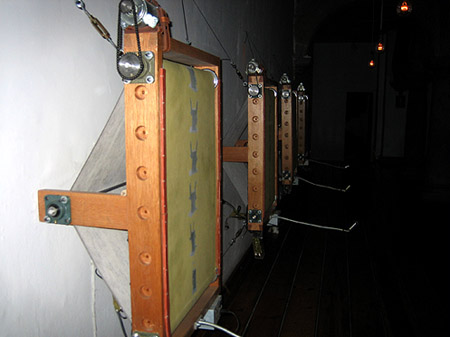When I feel like feeling old, I like to drop by And Or Gallery. It's not that the artists on view are often young enough to technically be my offspring. That phenomenon has become so common it hardly gets my attention. No, at And Or the problem is that I frequently have no idea what is going on with the art itself.
The current exhibition features work by Arcangel Constatini from Mexico City and JODI, a European team who have pioneer status in the world of web-based art.
Constatini works with both old and new media. One piece combines a series of SX-70 Polaroids with a monitor linked to his web site. Another presents a film on an tiny monitor and a third has an almost creaky looking contraption that functions somewhat like those early side show attractions that created motion by rotating still images inside a revolving drum.
It's with JODI's work that I am completely at sea. Two monitors contain playable versions of Quake, which I understand is an early first-person shooter game. A wall projection displays Wolfenstein 3D. In every case the graphics have been stripped from the images and you see the revealed code – or something.
Although my name held first to third place on the board of the Dig Dug machine at my neighborhood Safeway thirty years ago, that was my last contact with arcade or video games. And I never had any interest in what made them work. If I came on JODI's works without a program to explain what was going on , I would have no idea what I was looking at. And my understanding of it remains vague.
JODI's deconstructions of these games were first done in the late 1990's and they have already entered the web art canon. They have newer, dual monitor piece at the gallery that appropriates TV footage of children's programming with other web material. Watching it, I realized that perhaps both this piece and the altered video games up front were the latest incarnations of Pop Art. In the 1960's, artists turned to comics, the movies, and the boom in Post World War II consumer culture for imagery they could simultaneously analyze and celebrate. For this generation, the source material is video, and rather than Brillo Boxes and benday dots, we are getting Wolfenstein 3D with the graphics stripped out.
I'd be interested to know if this is a hopelessly old fogy approach to this work.
APROPOS OF NOTHING: My faith in country music has been restored. There is song on the radio now that contains the lyric – and maybe the title — “I want to check you for ticks.”



